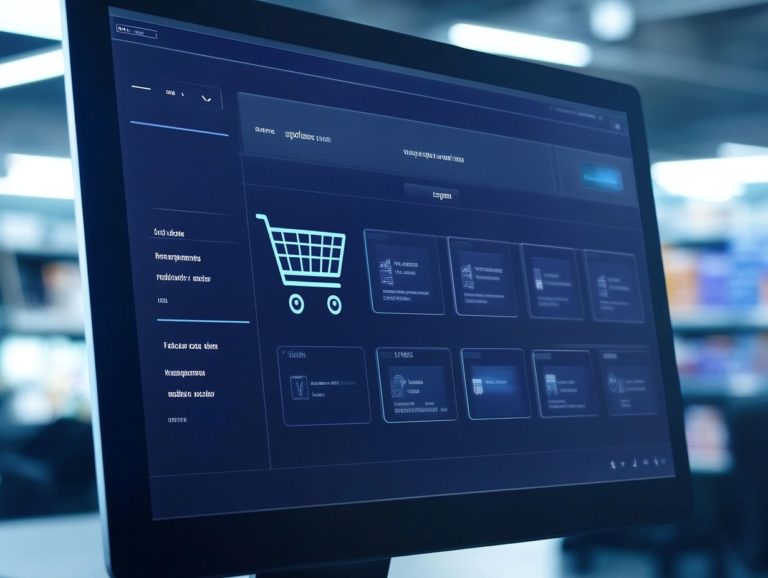How to Optimize Your Site’s Load Time
Today, websites need to load quickly. This is crucial for user experience and search engine rankings.
A slow-loading site leads to frustration and rising bounce rates. Users expect instant access to information.
This article covers key factors that affect load time. Topics include image optimization, caching, and CDNs, which help deliver website content faster to users.
By grasping and applying these strategies, you can significantly enhance your website’s performance and maintain visitor engagement.
Let s dive in and discover how you can speed up your site today!
Contents
- Key Takeaways:
- The Importance of Site Load Time
- Factors Affecting Site Load Time
- Optimizing Images for Faster Load Time
- Using Caching to Improve Load Time
- Minimizing HTTP Requests for Faster Load Time
- Utilizing Content Delivery Networks (CDNs)
- Frequently Asked Questions
- What is site load time and why is it important to optimize?
- How do I measure my site’s load time?
- What are some common factors that can slow down a website’s load time?
- How can I optimize my site’s load time?
- What is a good benchmark for site load time?
- Can optimizing my site’s load time also help with mobile users?
Key Takeaways:

- A slow site frustrates users and drops your SEO rankings.
- Compress images and enable caching to see immediate improvements.
- Global users benefit greatly from a content delivery network.
The Importance of Site Load Time
Site load time is more than just a technical issue; it is a cornerstone of user experience and search engine optimization (SEO). It profoundly influences how visitors engage with your web pages and can drastically impact bounce rates.
A swift loading speed is crucial for maintaining user interest and encouraging repeat visits. This ultimately affects your website’s performance and visibility in search engine results. This is especially pertinent in the context of Google’s Core Web Vitals updates, which emphasize speed as a vital ranking factor.
Impact on User Experience and SEO
The impact of loading speed on user experience is transformative. Studies indicate that even a one-second delay in page loading can lead to decreased visitor engagement and increased bounce rates, affecting your SEO rankings on platforms like Google.
Research from Kissmetrics reveals that 47% of users expect a web page to load in two seconds or less. An astonishing 40% will abandon a site that takes more than three seconds to fully load. This direct correlation underscores the critical importance of faster loading times, as they significantly enhance user satisfaction, which, in turn, influences how search engines assess a site’s ranking potential.
With Core Web Vitals now playing a pivotal role in ranking factors, metrics such as LCP (Largest Contentful Paint) and FID (First Input Delay) are essential for maintaining web traffic while providing a seamless browsing experience. Therefore, prioritizing loading speed is a fundamental pillar of effective SEO strategies.
Factors Affecting Site Load Time
Several factors can profoundly influence your site s load time. The number of HTTP requests, the size of downloads, the efficiency of JavaScript loading, and the presence of render-blocking scripts all play crucial roles in determining your overall page speed and enhancing user experience.
Common Culprits and How to Identify Them
Identifying the common culprits behind slow loading speeds requires a methodical approach. Utilize performance benchmarks and web performance analytics data, along with speed tests from tools like GTmetrix and Pingdom, to pinpoint the areas that need improvement.
Analyzing specific factors affecting your site s performance can lead to significant enhancements. Issues such as resource-demanding plugins often drag down load times. Inefficient coding practices, like overly complex scripts or excessive HTTP requests, can exacerbate delays. By leveraging analytical tools, you can assess these elements in detail.
For example, using GTmetrix can illuminate critical areas, such as image optimization or caching opportunities, helping you streamline processes and boost your site s overall responsiveness.
Optimizing Images for Faster Load Time

Image optimization is vital for enhancing your website’s loading speed. By using methods to reduce file sizes, like compression and lazy loading, you can greatly improve your site’s performance.
Prioritizing these strategies streamlines user experience and contributes to a polished online presence.
Best Practices for Image Compression and Formats
To maximize website performance, embrace best practices for image compression and formats. Focus on reducing download sizes while maintaining quality to enhance user experience.
Selecting the right image format significantly influences loading times. For instance, JPEG is often preferred for photographs due to effective compression with minimal visible quality loss. In contrast, PNG is ideal for graphics with transparent backgrounds, though it usually results in larger file sizes.
WebP is a modern format that offers superior compression without sacrificing quality, making it increasingly popular among developers. However, be aware of potential compatibility issues with older browsers.
Using compression techniques like lossless or lossy optimization helps balance image clarity and loading speed, enhancing user satisfaction.
Using Caching to Improve Load Time
Caching is a highly effective strategy for improving load times. A caching plugin optimizes your website s performance.
This process stores static versions of your web pages, reducing server load and enhancing user experience.
Types of Caching and How to Implement Them
Knowing the types of caching like browser caching and server-side caching can greatly boost your website’s speed.
By utilizing different caching strategies, such as CDN caching and object caching, you can optimize load times and alleviate server strain. Browser caching allows users’ devices to store resources locally, resulting in faster return visits. Meanwhile, server-side caching swiftly processes and serves data, minimizing database queries.
Implementing these strategies enhances user experience and improves your SEO rankings since faster sites are favored in search engine results. A comprehensive caching approach yields remarkable gains in efficiency and user satisfaction.
Minimizing HTTP Requests for Faster Load Time
Minimizing HTTP requests is essential for achieving faster load times. Reducing redirects and optimizing JavaScript loading significantly decreases the number of requests made by browsers.
This proactive approach improves your performance metrics and leads to a smoother and more efficient user experience.
Tips for Reducing the Number of Requests

To reduce requests and elevate your performance metrics, consider strategies like eliminating unnecessary redirects and optimizing asset download sizes.
Consolidating your CSS and JavaScript files can greatly lower the total number of requests. Using tools like Gzip compression helps shrink file sizes, leading to quicker load times and an improved user experience.
By leveraging browser caching, repeat visitors can access stored versions of resources without generating new requests, effectively speeding up page rendering.
Graphic optimizers such as TinyPNG or ImageOptim compress images without losing quality, ensuring visuals remain sharp while decreasing load times.
Use tools like Google PageSpeed Insights today to discover how to make your site faster by analyzing performance and pinpointing areas for improvement.
Summary: Optimizing images, utilizing caching, and minimizing HTTP requests are essential strategies for enhancing website speed and user satisfaction. Act now to improve your site s speed and delight your visitors!
Utilizing Content Delivery Networks (CDNs)
Utilizing a Content Delivery Network (CDN) is a smart way to enhance your website’s performance. By distributing your content across a network of servers, you ensure that users receive faster content delivery tailored to their geographic location.
This approach not only optimizes load times but also elevates the overall user experience. It makes your site more responsive and engaging.
Benefits and How to Set Up a CDN
A CDN offers substantial benefits. It improves website performance and reduces load times.
These advantages ultimately lead to better user engagement and retention. Imagine your users enjoying a seamless experience!
To set up a CDN, you’ll want to follow several strategic steps:
- Update your DNS settings to link to the CDN.
- Configure caching rules to optimize performance.
- Ensure that resources such as images, scripts, and stylesheets are efficiently routed through the distributed network.
By taking these steps, you can significantly reduce latency, providing an optimal browsing experience for users around the globe.
Frequently Asked Questions
What is site load time and why is it important to optimize?
Site load time is how long it takes for a page to fully load in your browser. Faster load times mean happier users, higher search engine rankings, and increased website traffic.
How do I measure my site’s load time?

There are various tools available, such as Google’s PageSpeed Insights, GTmetrix, and Pingdom, that can measure your site’s load time. These tools provide detailed reports on factors that may be slowing it down.
What are some common factors that can slow down a website’s load time?
Common factors include large image files, excessive use of plugins or scripts, server issues, and bulky code. Regularly monitoring these factors is crucial for maintaining fast load times.
How can I optimize my site’s load time?
Some ways to optimize include compressing images, minimizing HTTP requests, and reducing the use of plugins. Using a content delivery network (CDN) and implementing browser caching are also effective strategies. Remember to regularly update and optimize your code!
What is a good benchmark for site load time?
Ideally, a webpage should load within 2-3 seconds. However, acceptable load times may vary based on the type of website. Regularly monitor and strive to improve your site’s load time.
Can optimizing my site’s load time also help with mobile users?
Yes, optimizing for load time greatly benefits mobile users. A fast load time increases the likelihood that mobile users will stay on your site, leading to positive experiences and potential conversions.






